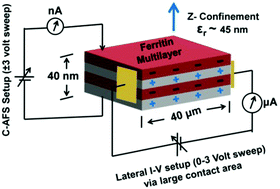Long-range solid-state electron transport through ferritin multilayers†
Abstract
We have developed a multilayered protein-based material using iron-storage protein ferritin, where only proteins were used as components, having no other chemical/biochemical moieties interspersed in between the layers. A simple method of layer-by-layer (LbL) electrostatic adsorption of successive layers of cationized HoSF (with positive surface charge) and native HoSF (with negative surface charge) onto substrates like heavily doped silicon and optically transparent quartz was employed for multilayer (up to 12 layers) fabrication. This technique is economical and time-effective, and is advantageous over other related methods, for example, spin-coating, in several aspects. From optical absorption analysis, it is elicited that the holoferritin multilayer is an indirect band gap material, while the iron-free apo form is a direct band gap material. Importantly, the ferritin multilayer is found to be capable of long-range electron transport – the maximum range being 40 nm for ‘across the multilayer’ (or vertical) transport as observed in a C-AFS study, and 40 μm for ‘along the multilayer’ (or lateral) transport as observed in an interdigitated electrode-based measurement. We found that the substrate influence minimizes as the layer thickness increases. It is also observed that the multilayer is by and large electronically homogeneous, probably because no intermediate junctions of other materials are present between the protein layers. The ferritin multilayer can be considered as a bulk electron transport system beyond 45 nm layer thickness, meaning an unusually long exciton radius of 45 nm, which is one of the longest exciton radii reported so far. This is also the first report of electronic confinement inside any biomaterial.



 Please wait while we load your content...
Please wait while we load your content...